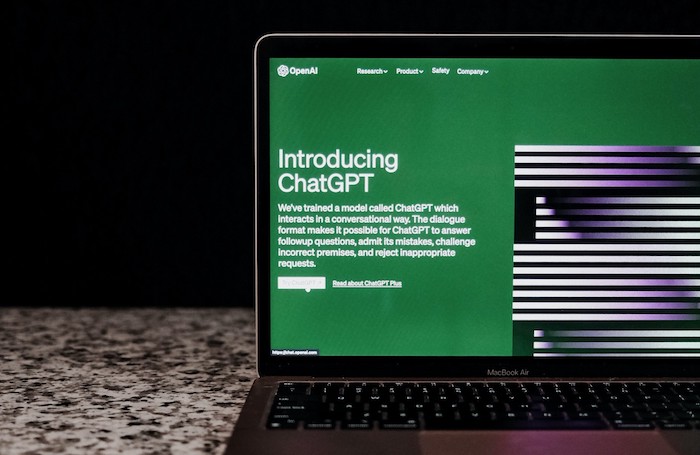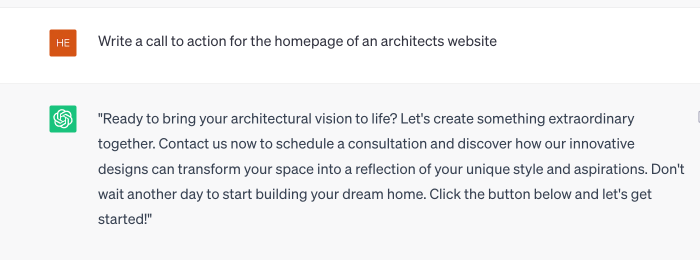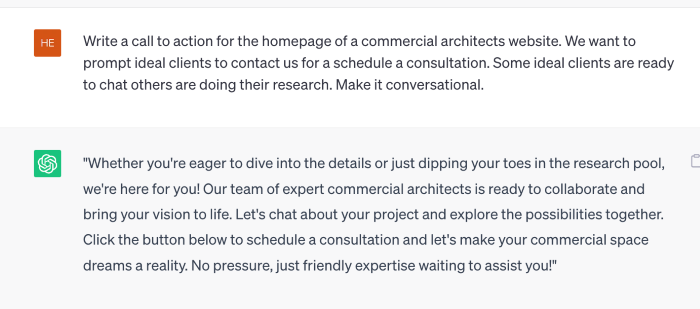Whether you love it or hate it, are excited by its problem-solving abilities or are terrified by its potentially negative implications, Artificial Intelligence (AI) is here to stay.
Government task forces are hastily being assembled and are scrambling to understand and explore guard-railing measures for the myriad tools that hundreds of millions already use worldwide. Meanwhile, creative professionals like architects have found that text-to-image and text-to-text generators have greatly altered their processes as of right now.
When a new version of the AI chatbot ChatGPT was released in late 2022, it provided users with an extraordinarily powerful tool that can create essays, reports, and short and long form text on any subject at the touch of a button.
To illustrate its fast growing popularity, both Microsoft and Google have now installed their own versions into their search engines.
More importantly, it does architecture too. Asking ChatGPT how UK architects’ practices can improve their productivity by using the app, it generates a very plausible and well-written case for embedding ChatGPT into workflows within around five seconds of asking. Many of its suggestions revolve around streamlining communications and generating reports.
How can ChatGPT be used?
Two uses that ChatGPT itself recommends to architects, both of which are unquestionably valuable, are as a research and retrieval tool, and a drafting tool for written content.
However, the answers are only as good as the questions or ‘prompts’ that are asked, while one of the great differentiators of ChatGPT is that you can ask follow up questions and the app will answer them in the context of the previous questions. It stays on topic.
This allows the user to drill down readily to greater detail or technicality, or veer off into a more specific line of inquiry, perhaps having been prompted by the previous answer.
What is ChatGPT?
When was ChatGPT invented?
OpenAI first introduced its GPT (Generative Pre-trained Transformer) Large Language Model in 2018.
How did it start?
ChatGPT first started with GPT-1. Its successor was GPT-2, which launched in February 2019 and displayed significant improvements in understanding language and its abilities to generate text.
What came next?
ChatGPT 3 and then ChatGPT 3.5 followed, in 2020. ChatGPT 4 was then launched in November 2022 on the OpenAI website.
How does it do what it does?
The bedrock of the technology is the Generative Pre-trained Transformer ‘architecture’.
What does the acronym really mean?
‘Generative’ describes how GPT models are able to generate content based on "patterns and context they have learned from training date". ‘Pre-trained’ means that models are pre-trained on huge amounts of text data from different sources, which allows them to learn grammar, linguistic patterns, facts and context. Finally, ‘Transformer’ refers to the neural network model designed for ‘natural language processing tasks’. This architecture uses ‘self-attention mechanisms and parallel processing’ to produce accurate copy at large scale. (Source: The Insane App)

How ChatGPT can be a great starting point for producing copy
Nikita Morell, a copywriter who works exclusively with architects, says in terms of generating copy, architects can use ChatGPT for drafting initial outlines for content. For example, this could include project descriptions, blog articles, proposals and press releases, or even for writing website copy (ie: website taglines, calls to action or biographies).
For an architect who is not a naturally strong writer, ChatGPT gives you something to start with, she says, which can then be augmented with your own creativity and expertise.
“ChatGPT can be a useful tool for brainstorming and generating new research ideas,” she says. “It often helps spark new ideas or provides different perspectives. For example, if I’m trying to brainstorm ideas for website taglines, I might prompt it with: ‘Come up with a clever and easy-to-understand analogy for [insert subject]’, such as the ‘challenges of hiring an architect’.”
ChatGPT is also smart enough to tailor material to a prospective client’s needs.
“Architects could use ChatGPT to find clients’ ‘pain points’, such as specific problems or frustrations they might have experienced when hiring an architect in the past,” she suggests.
“Identifying these 'pain points' allows architects to align their messaging with their ideal client’s needs and challenges and can enhance the effectiveness of marketing and business development efforts.
“A prompt example would be: ‘Give me a list of 10 pain points [insert your ideal clients] may be dealing with in regards to [insert your service]’, or ‘Give me a list of 10 pain points homeowners may be dealing with when hiring a residential architect for the first time’.”
Example of a limited ChatGPT prompt:

Example of a better ChatGPT prompt:

How to use prompts to make your copy more accurate and personable
For copywriting, the biggest downside is with the tone of voice, Nikita suggests. As an AI language model, ChatGPT generates responses based on patterns and examples learned from its training data, without a true understanding of context or emotions. This can sometimes result in a lack of nuance or the inability to convey emotions effectively.
“You can prompt ChatGPT to ‘make it more friendly’ or ‘make it more casual’, but it’s very hard to generate your practice’s exact tone of voice accurately,” she continues. “In my experience, I also found ChatGPT struggles to express sarcasm, humour, empathy, or other subtle aspects of human communication. For example, it might respond to a casual question with a formal tone or fail to capture the intended light-heartedness of a conversation.”
Nikita’s verdict is that ChatGPT is an excellent tool when used correctly. “It’s really important to remember ChatGPT is pulling from un-curated internet content, which includes a lot of junk. So, while it tries its best to give accurate information, it’s not always spot-on with the facts. It has zero ability to identify what is accurate information against what is false or inaccurate.”
And with that in mind, Nikita concludes with this piece of advice: while the likes of ChatGPT can act as an incredibly fast and powerful research tool - like your very own virtual research assistant – and produce copy for myriad uses, architects must still ensure that they validate any critical information from reliable sources.
Learn more about AI with our feature - Artificial Intelligence: How can architects incorporate Midjourney into their design process?
Thanks to Nikita Morell, founder, Architects WordShop and NikitaMorell.com.
Text by Neal Morris. This is a Professional Feature edited by the RIBA Practice team. Send us your feedback and ideas.
RIBA Core Curriculum topic: Design, construction and technology.
As part of the flexible RIBA CPD programme, professional features count as microlearning. See further information on the updated RIBA CPD core curriculum and on fulfilling your CPD requirements as an RIBA Chartered Member.









